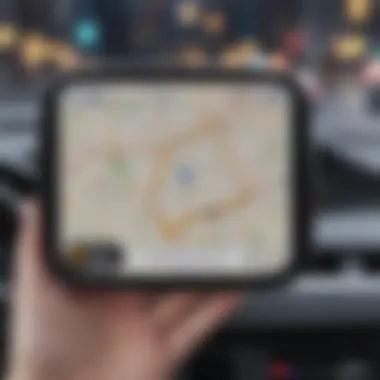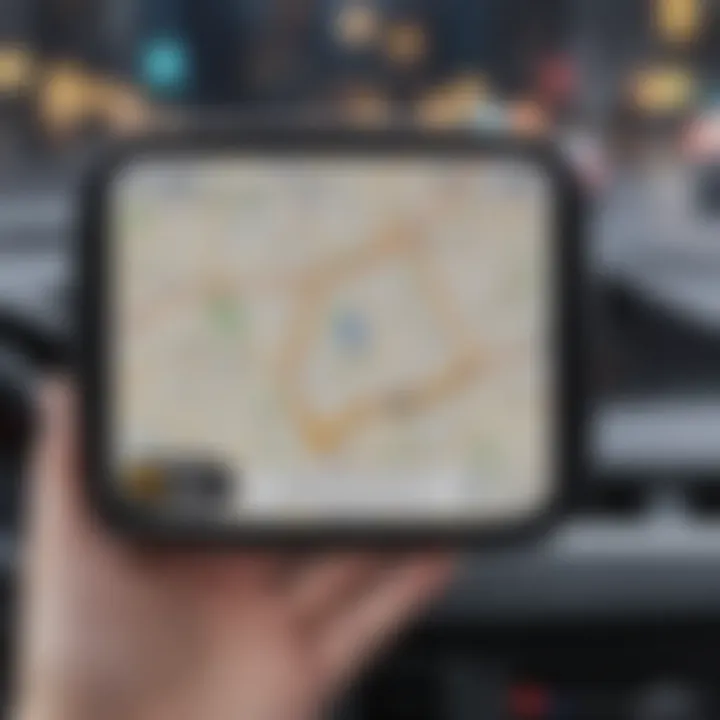The Evolution and Functionality of Navigation Apps


Intro
The rise of navigation apps marks a significant shift in how individuals interact with their environment. With the proliferation of smartphones, users now have access to a world of mapping and guidance tools at their fingertips. This article will delve into the evolution of these applications, exploring their foundational technologies and the design principles that have shaped modern navigation.
As personal and commercial mobility increased, so did the need for efficient navigation solutions. Traditional paper maps are now largely replaced by digital counterparts that offer real-time directions, traffic updates, and location sharing. This transformation has not only changed how we travel but also influenced our social interactions and urban planning.
We will examine various navigation apps currently available, their unique functionalities, and the implications of GPS technology in our daily journeys. Through this exploration, we aim to present a comprehensive view of the technological advancements that have made navigation apps an essential part of contemporary life.
Prelims to Navigation Applications
In an age where technology rapidly advances, the role of navigation applications has become central in our daily routines. These apps not only provide geographic directions, but they also alter how we interact with our environment. Understanding the significance of navigation applications offers insights into how we can utilize them more effectively.
Definition of Navigation Apps
Navigation applications, commonly referred to as navigation apps, are software programs designed primarily to assist users in determining routes and locations using GPS and map data. They facilitate turn-by-turn directions, traffic updates, and sometimes even local insights based on user preferences. Unlike standalone GPS devices, these apps operate on smartphones and integrate with various online services to optimize user experience.
Historical Context
The history of navigation apps mirrors the evolution of mobile technology itself. In the early days, traditional maps and standalone GPS devices dominated the navigation landscape. However, as smartphones gained popularity, the need for more versatile solutions emerged. In 2005, the introduction of Google Maps marked a turning point in navigation services. This was followed by Apple launching its map service in 2012. The incorporation of real-time data paved the way for significant advancements in user interaction and overall functionality. Over time, navigation apps have grown from basic route planners to complex systems that analyze traffic patterns, suggest alternative routes, and even provide personalized recommendations based on user habits. As we delve further into the components that shape these applications, it is clear that their evolution has reshaped not just navigation but also how we approach our daily travels.
Technology Behind Navigation Apps
The development of navigation applications hinges significantly on the underlying technology. This tech enables users to access precise directions and insightful data about various locations. Understanding the technology helps to uncover the nuances that enhance user experience and make navigation apps integral to daily life. This section looks into GPS technology, data collection and processing, and how map data management contributes to the efficacy of these apps.
GPS Technology Overview
GPS, or Global Positioning System, is the cornerstone of navigation applications. This technology allows devices to determine their precise location anywhere on Earth. The system operates through a network of satellites that transmit signals to GPS receivers on mobile devices. The receiver interprets these signals to calculate the device's latitude and longitude.
Having access to GPS technology offers numerous advantages:
- Precision: Users receive accurate location information, enabling reliable route finding.
- Real-time Updates: The GPS updates the user's position in real time, helping to navigate changing environments.
- Global Accessibility: GPS is available worldwide, making it usable regardless of location.
Understanding GPS technology is essential for appreciating how navigation apps function seamlessly to provide directions.
Data Collection and Processing
Navigation apps depend heavily on data collection and processing to deliver relevant information. The apps collect data from various sources, including user inputs, traffic patterns, road conditions, and geographic information systems. This data helps generate accurate maps and notable points of interest along the route.
Data processing involves complex algorithms designed to:
- Analyze Traffic Conditions: Real-time data helps identify obstacles and congestion on the road, redirecting users as needed.
- Optimize Routes: Based on the user's current location and destination, apps calculate the most efficient pathways.
- Deliver Contextual Information: Apps may provide information about nearby restaurants, gas stations, or historic sites based on the user's route.
Overall, effective data collection and processing enable navigation apps to adapt to dynamic situations and enhance the user's journey.
Map Data Management
Map data management is integral to the functionality of navigation applications. It involves the organization, maintenance, and updating of geographical data to ensure accuracy. Companies like Google Maps and Apple Maps spend considerable resources on map data management to provide comprehensive services.
Key aspects of map data management include:
- Regular Updates: Maps need constant updates to reflect new roads, construction, and changes to existing paths.
- User Contributions: Many navigation apps allow users to contribute data, enhancing map accuracy. Reports from users about road closures or traffic conditions provide invaluable real-time information.
- Data Storage Solutions: Robust data storage ensures that vast amounts of geographical information are accessible promptly, allowing for efficient user queries.


Effective map data management is crucial as it ensures that users receive precise and timely information, making their navigation experience smooth.
User Experience in Navigation Apps
User experience plays a pivotal role in the effectiveness of navigation applications. For avid smartphone users and tech enthusiasts, the way an app feels and functions can greatly influence its adoption and continued use. Therefore, understanding the intricacies of user experience becomes essential to enhance engagement and utility. This section dives into three key areas: interface design principles, user interaction and satisfaction, and accessibility features.
Interface Design Principles
Creating an intuitive interface is fundamental for any navigation app. Users expect to access directions with minimal effort. Well-designed interfaces prioritize simplicity and clarity. Key principles include:
- Consistency: The app should maintain similar elements across all screens. Familiar layouts reduce cognitive load.
- Feedback: Users benefit from immediate responses to their actions. This can be in the form of visual cues or sound notifications.
- Visuability: Key features, like start and stop navigation buttons, should be easy to find. Effective iconography helps convey messages quickly without needing textual explanation.
These principles contribute to ease of use. Users who encounter intuitive designs are likely to engage more and prefer specific apps over others. Google Maps and Waze exemplify effective adherence to interface design principles.
User Interaction and Satisfaction
User interaction defines the relationship between the user and the navigation app. Satisfaction levels can fluctuate depending on how effectively the app meets user needs. To enhance interaction, developers must consider various factors:
- Navigation Accuracy: Real-time traffic data and route suggestions increase satisfaction as users feel more secure in their travel choices.
- Error Management: When users make mistakes, such as entering incorrect destinations, how the app responds drastically impacts user perception. Clear options to correct errors are vital.
- Personalization: Offering tailored suggestions based on user behavior can lead to improved engagement. If the app learns a user’s common routes, it can provide more relevant recommendations.
An engaging user experience translates to satisfaction. Satisfied users are more likely to recommend the app to others.
Accessibility Features
Navigating the digital world should be an inclusive experience for everyone. For navigation apps, implementing robust accessibility features is crucial. These features help ensure that all individuals, regardless of ability, can benefit from the technology. Consider the following:
- Voice Commands: Enabling hands-free operation enhances usability, especially for visually impaired users.
- High-Contrast Modes: For those with visual impairments, options to switch to high-contrast visuals ensure that maps and notifications are noticeable.
- Text Scaling: Users should have the ability to adjust text size according to their needs.
Accessibility is not an afterthought—it is a fundamental component of good design.
By addressing the diverse needs of users, navigation apps can promote long-term adoption and satisfaction.
In summary, user experience is a multi-faceted aspect of navigation applications. Effective interface design, positive interactions, and accessible features combine to create a cohesive and useful tool for all users.
Comparative Analysis of Popular Navigation Apps
The comparative analysis of popular navigation apps is crucial in understanding the diverse options available to users. Each app has its own strengths, weaknesses, and unique features that can significantly affect user experience. Assessing these differences assists smartphone users and tech enthusiasts alike in making informed choices tailored to their specific needs. This exploration can reveal insights about usability, functionalities, and even market trends that could influence future app development in the navigation space.
Google Maps
Google Maps is perhaps the most recognized navigation app worldwide. Launched in 2005, it has evolved into a comprehensive tool not just for driving directions, but also for public transit, walking, and cycling. The app offers real-time traffic data, which helps users avoid congested routes, ensuring a smoother journey.
Key features include:
- Street View: Provides users with panoramic views of streets, enhancing the navigation experience.
- Business Listings: Offers extensive information about local businesses, including reviews, hours, and services.
- Offline Maps: Users can download maps for offline access, making it suitable for regions with poor connectivity.
The integration of Google Assistant allows for voice commands and hands-free navigation. This feature further boosts safety, enabling drivers to interact with the app without taking their hands off the wheel. Overall, Google Maps' continual updates and feature expansions make it a leading choice among navigation apps.
Waze
Waze distinguishes itself through community-driven data. Acquired by Google in 2013, it leverages user input in real time to offer the most current information on road conditions. This collaborative aspect sets it apart from traditional navigation apps.
The critical features of Waze include:


- User Alerts: Users can report traffic jams, accidents, and police presence, which are immediately shared with the community.
- Route Optimization: Waze calculates the fastest route based on real-time data, ensuring users avoid delays.
- Gas Prices: Provides real-time gas prices reported by users, helping motorists find the cheapest options on their route.
This app has a particularly strong following among commuters, due to its commitment to real-time traffic conditions and community involvement. Waze enhances the driving experience by making it feel more interactive and responsive to current situations.
Apple Maps
Apple Maps has undergone significant improvements since its launch in 2012. Initially criticized for inaccuracies and limited features, it has steadily become a viable competitor to Google Maps. Apple Maps is especially integrated into the iOS ecosystem, providing seamless functionality for iPhone users.
Notable features include:
- Flyover: Offers a 3D view of cities, giving users a unique perspective.
- Transit Directions: Supports multi-modal travel, incorporating public transportation options effectively.
- Privacy Focus: Apple emphasizes user privacy, ensuring location data is anonymized, giving an edge in data security.
While it may not have the breadth of information that Google Maps does, Apple Maps has carved out a niche, particularly among Apple device loyalists who appreciate its integration and simplicity.
Other Notable Apps
There are several other noteworthy navigation apps that offer unique features and functionalities:
- HERE WeGo: Known for its offline capabilities, it is ideal for users in areas with limited internet access. It has strong public transport directions and even allows users to choose their preferred route type.
- Maps.me: Provides detailed offline maps, making it a preferred choice for travelers. It is user-friendly and has curated content for various locations.
- Sygic: This app integrates advanced navigation features, including augmented reality and head-up display options. It caters to both casual users and professionals, with a focus on comprehensive offline capabilities.
Understanding these apps allows users to align their choices with their requirements, aiding them in navigating the complexities of travel in today's technology-driven environment. As technology progresses, the efficacy and functionality of navigation apps will continue to adapt, meeting the evolving demands of their users.
Impact of Navigation Apps on Daily Life
The influence of navigation apps transcends simple route finding. They have reshaped how people engage with their environment, impacting both personal and commercial activities. Navigation applications, such as Google Maps and Waze, have become ubiquitous, making them integral tools for mobility in modern society. Their role in daily life is multifaceted, bringing benefits that enhance travel experiences, support local economies, and present new challenges regarding environmental sustainability.
Influence on Travel Habits
Navigation apps have drastically changed travel habits, making planning easier. Users rely on these applications not just for directions but for discovering points of interest along the way. As a result, the spontaneity in travel planning has increased. Travelers can find restaurants, gas stations, or parks without prior research. This flexibility allows for a more enjoyable experience, as the uncertainty of getting lost has diminished. Additionally, many apps provide real-time traffic updates. This functionality encourages drivers to consider alternative routes that minimize travel time, thus optimizing their journeys. Regular users often find they can reach destinations quicker than before.
People also become more reliant on technology for travel. If someone needs to travel to an unfamiliar area, navigation apps provide reassurance. Some studies suggest that this reliance can lead to decreased memorization of routes. As familiarity with locations decreases, the ability to navigate without assistance could weaken over time. Hence, while convenience increases, the capacity for traditional navigation skills may suffer.
Effects on Local Businesses
Navigation apps significantly influence local businesses as they often feature reviews, photos, and operating hours. Small businesses that utilize these apps can reach more potential customers. When someone searches for "coffee shops nearby," the app's algorithm directs users to local options. This exposure can be critical for businesses trying to thrive in competitive urban zones. Many local eateries and shops have reported increased foot traffic since optimizing their presence on these maps.
However, it's not entirely beneficial. Local businesses must compete with bigger brands that have greater visibility on these platforms. The prioritization algorithms may favor larger chains over independent shops, which can reduce the market share for small establishments. For smaller players, investing time to secure a good standing is necessary. If they do not manage their online presence effectively, they risk being overlooked.
Environmental Considerations
The environmental implications of navigation apps are notable. While they can contribute to lower emissions by guiding drivers away from congested routes, they may also encourage more driving. An obvious concern is that by making travel easier, more people might choose to drive rather than explore alternative transportation methods, like cycling or public transit. Some studies point to an increase in vehicle miles traveled due to these apps.
As a response, companies are working to develop features that promote environmentally friendly transport options. For instance, applications such as Google Maps now allow users to choose between driving, cycling, or public transit options. Users now have more information to make conscious commuting decisions that consider ecological impacts.
"Navigation applications are more than just tools for finding directions; they affect travel habits, support local economies, and introduce environmental considerations that society must address."
Challenges in Navigation App Development
The field of navigation app development is marked by constant evolution and innovation. However, with such growth comes significant challenges. Addressing these issues is crucial for developers to enhance user experience and maintain competitive advantage in a crowded market. This section will delve into three primary challenges: data privacy concerns, accuracy and reliability issues, and competition and market saturation. Each element plays a vital role in shaping the future of navigation technologies.
Data Privacy Concerns
In today's digital age, user data is a prized asset. Navigation apps often gather sensitive information, including location history and personal preferences. This raises substantial data privacy concerns. Users demand transparency about how their data is used, stored, and shared. Compliance with regulations like the General Data Protection Regulation (GDPR) in Europe adds another layer of complexity for developers.


- User Trust: To foster user loyalty, companies must prioritize data protection measures. Trust can be fragile. If a user feels their data is mishandled, they may abandon the app.
- Data Breaches: The risk of cyberattacks looms large. If an app suffers a data breach, it can lead to severe consequences for both the users and the company’s reputation.
"The importance of safeguarding user data cannot be overstated. Failure to do so can lead to significant backlash against a company."
Accuracy and Reliability Issues
Accuracy is paramount for navigation apps. A user relies on these applications for timely directions. When accuracy falters, it undermines the app's utility. Thus, ensuring precise mapping and real-time updates is essential.
- GPS Limitations: Factors such as environmental interference can impact GPS accuracy. Urban canyons, dense cloud cover, and other obstacles can hinder signal strength.
- Map Data Maintenance: Continuous updates are necessary. Map data can become obsolete quickly. A robust data management strategy is essential for providing reliable information.
Moreover, user feedback mechanisms can play a pivotal role in enhancing reliability. Users who report errors can contribute to improving the app’s performance in real time.
Competition and Market Saturation
The market for navigation apps is highly saturated. New applications spring up regularly, often with similar features. In such an environment, distinguishing one's product becomes challenging.
- Unique Features: To thrive, apps must offer unique features or superior usability that appeals to specific user demographics. Identifying target audiences and tailoring experiences is crucial for standing out.
- Marketing Strategies: Effective marketing campaigns can significantly influence an app's success. Companies must navigate advertising while providing genuine value to users.
As competition increases, developers must stay vigilant and innovative. The challenge lies in balancing enhancement and functionality amid consumer expectations and market pressures.
The challenges in developing navigation apps require thoughtful strategies. Addressing data privacy, ensuring accuracy, and navigating competition are vital to sustaining user satisfaction and loyalty.
The Future of Navigation Applications
The future of navigation applications is filled with potential and innovation. As society continues to embrace technology, these apps will only enhance daily life further. The significance of this topic lies in understanding how future advancements can transform the way we navigate our environment. Users will benefit from improved accuracy, enhanced features, and personalized experiences. Moreover, the interplay between emerging tech and user needs will likely shape navigation app functionalities in diverse ways.
Emerging Technologies
Artificial Intelligence
Artificial Intelligence (AI) is creating new pathways in navigation applications. One main aspect of AI is its ability to process vast amounts of data quickly. This contributes significantly to predicting traffic patterns and providing real-time updates. A key characteristic of AI is its machine learning capacity. This means it can improve as it gathers more data, thus providing a more accurate and tailored experience for users.
The unique feature of AI in navigation apps is its predictive algorithms. These algorithms analyze historical data to suggest the best routes. However, there are disadvantages to consider. Over-reliance on AI can sometimes lead to blind trust, causing users to overlook situational changes on the road.
Augmented Reality
Augmented Reality (AR) is increasingly relevant in navigation applications. AR enhances user experience by overlaying digital information on the physical world. This capability can provide real-time directions directly onto a user's view of the road or surroundings. A major advantage of AR is its interactive nature, which can make navigating unfamiliar areas more intuitive.
The unique feature of AR is the immersive visual guidance it offers. Users can see directions integrated into their environment. However, the technology's dependency on high-quality visuals can pose a disadvantage. Poor visibility or hardware limitations may reduce the effectiveness of augmented features.
Potential Trends
The navigation app sector will likely witness various trends in the coming years. One crucial trend is the integration of more personalized features. Apps may adapt to user commuting preferences and habits, enhancing the overall experience. Another trend is the growing focus on sustainability. As environmental awareness increases, future applications may prioritize routes that minimize carbon footprints.
Additionally, we may see partnerships between navigation apps and smart vehicle technology. This could lead to improved communication between vehicles and applications, fostering more efficient travel. Beyond these trends, users can expect constant enhancements in accuracy and data integration. Navigation applications are set to evolve significantly, aiming to improve daily commuting and travel experiences.
The End
Navigation apps have transformed the way we approach travel and daily commutes. The significance of these apps lies not only in their fundamental function of guiding users from point A to point B, but also in how they adapt to our increasingly mobile lifestyles. As we examined in prior sections, navigation applications integrate advanced technology, user-centered design, and do play a pivotal role in shaping our experiences on the road.
Summary of Key Points
Throughout this article, we have discussed several critical aspects concerning navigation apps:
- Definition and Historical Context: Understanding what navigation apps entail, including their evolution from basic maps to advanced GPS systems, illustrates their trajectory in society.
- Technology Behind Navigation Apps: The reliance on GPS technology for location data and the gathering and management of map information highlight the tech backbone enabling these applications to function.
- User Experience: Emphasizing interface design, user interaction, and accessibility features showcases how crucial user satisfaction is to the overall effectiveness of navigation apps.
- Comparative Analysis: Comparing Google Maps, Waze, Apple Maps, and others reveals the unique selling points of each application, informing users of their options.
- Impact on Daily Life: This segment enlightened on how navigation apps influence travel choices, local business dynamics, and environmental factors.
- Challenges: Acknowledging data privacy issues, accuracy problems, and market competition addresses the growing concerns consumers and developers face.
- Future Trends: Discussing emerging technologies such as artificial intelligence and augmented reality, we glimpsed into the potential advancements shaping the next era of navigation.
Final Thoughts on Navigation Apps
As mobile technology continues to evolve, navigation apps are likely to become even more integral to our everyday lives. The increasing integration of artificial intelligence will enable these apps to offer personalized experiences, making journeys smoother and more efficient. Moreover, as we grow more conscious of sustainability, navigation apps may incorporate features that encourage eco-friendlier travel options, influencing user behavior.



